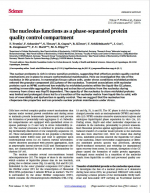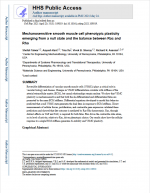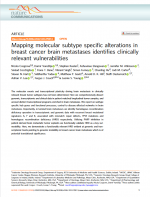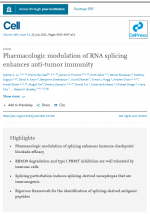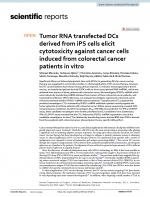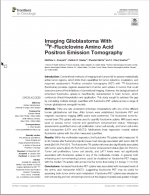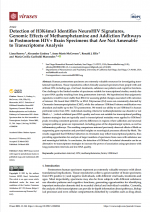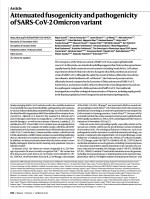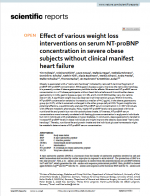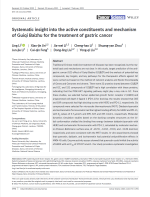08.04.2022
The nucleolus functions as a phase-separated protein quality control c... Science, 2019
Abstract The nuclear proteome is rich in stress-sensitive proteins, which suggests that effective protein quality control mechanisms are in place to ensure conformational maintenance. We investigated the role of the nucleolus in this process. In mammalian tissue culture cells under stress conditions, misfolded proteins entered the granular component (GC) phase of the nucleolus. Transient associations with nucleolar proteins such as NPM1 conferred low mobility to misfolded proteins within the liquid-like GC phase, avoiding irreversible aggr...
01.04.2022
Mechanosensitive smooth muscle cell phenotypic plasticity emerging fro... Cell Reports, 2021
Abstract THIS WEEK: Reversible differentiation of vascular smooth muscle cells (VSMCs) plays a critical role in vascular biology and disease. Changes in VSMC differentiation correlate with stiffness of the arterial extracellular matrix (ECM), but causal relationships remain unclear. We show that VSMC plasticity is mechanosensitive and that both the de-differentiated and differentiated fates are promoted by the same ECM stiffness. Differential equations developed to model this behavior predicted that a null VSMC state generat...
25.03.2022
Mapping molecular subtype specific alterations in breast cancer brain... Mapping molecular subtype specific alterations in breast cancer brain...
Abstract The molecular events and transcriptional plasticity driving brain metastasis in clinically relevant breast tumor subtypes has not been determined. Here we comprehensively dissect genomic, transcriptomic and clinical data in patient-matched longitudinal tumor samples, and unravel distinct transcriptional programs enriched in brain metastasis. We report on subtype specific hub genes and functional processes, central to disease-affected networks in brain metastasis. Importantly, in luminal brain metastases we identify homologous recomb...
18.03.2022
Pharmacologic modulation of RNA splicing enhances anti-tumor immunity Pharmacologic modulation of RNA splicing enhances anti-tumor immunity
Abstract Although mutations in DNA are the best-studied source of neoantigens that determine response to immune checkpoint blockade, alterations in RNA splicing within cancer cells could similarly result in neoepitope production. However, the endogenous
11.03.2022
Tumor RNA transfected DCs derived from iPS cells elicit cytotoxicity a... Tumor RNA transfected DCs derived from iPS cells elicit cytotoxicity a...
Abstract Significant efficacy of induced pluripotent stem cells (iPSCs) in generating DCs for cancer vaccine therapy was suggested in our previous studies. In clinical application of DC vaccine therapy, however, few DC vaccine systems have shown strong clinical response. To enhance immunogenicity in the DC vaccine, we transfected patient-derived iPSDCs with in vitro transcriptional RNA (ivtRNA), which was obtained from tumors of three patients with colorectal cancer. We investigated iPSDCs-ivtRNA which were induced by transfecting ivtRNA o...
25.02.2022
Imaging Glioblastoma With 18F-Fluciclovine Amino Acid Positron Emissio... Imaging Glioblastoma With 18F-Fluciclovine Amino Acid Positron Emissio...
Introduction: Conventional methods of imaging brain tumors fail to assess metabolically active tumor regions, which limits their capabilities for tumor detection, localization, and response assessment. Positron emission tomography (PET) with 18F-fluciclovine (fluciclovine) provides regional assessment of amino acid uptake in tumors that could overcome some of the limitations of conventional imaging. However, the biological basis of enhanced fluciclovine uptake is insufficiently characterized in brain tumors, which confounds clinical i...
18.02.2022
Detection of H3K4me3 Identifies NeuroHIV Signatures, Genomic Effects o... Detection of H3K4me3 Identifies NeuroHIV Signatures, Genomic Effects o...
Abstract Human postmortem specimens are extremely valuable resources for investigating translational hypotheses. Tissue repositories collect clinically assessed specimens from people with and without HIV, including age, viral load, treatments, substance use patterns and cognitive functions. One challenge is the limited number of specimens suitable for transcriptional studies, mainly due to poor RNA quality resulting from long postmortem intervals. We hypothesized that epigenomic signatures would be more stable than RNA for assessing global...
11.02.2022
Attenuated fusogenicity and pathogenicity of SARS-CoV-2 Omicron varian... Attenuated fusogenicity and pathogenicity of SARS-CoV-2 Omicron varian...
Abstract The emergence of a new severe acute respiratory syndrome coronavirus 2 (SARS-CoV-2) variant, Omicron, is an urgent global health concern (ref.1). Our statistical modelling suggests that Omicron has spread more rapidly than the Delta variant in several countries including South Africa. Cell culture experiments show that Omicron is less fusogenic than Delta and an ancestral SARS-CoV-2 strain. Although the spike (S) protein of Delta is efficiently cleaved into two subunits, which facilitates cell–cell fusion2,3, Omicron S is le...
28.01.2022
Effect of various weight loss interventions on serum NT-proBNP concent... Effect of various weight loss interventions on serum NT-proBNP concent...
Abstract Obesity is associated with a "natriuretic handicap" indicated by reduced N-terminal fragment of proBNP (NT-proBNP) concentration. While gastric bypass surgery improves the natriuretic handicap, it is presently unclear if sleeve gastrectomy exhibits similar effects. We examined NT-proBNP serum concentration in n = 72 obese participants without heart failure before and 6 months after sleeve gastrectomy (n = 28), gastric bypass surgery (n = 19), and 3-month 800 kcal/day very-low calorie diet (n = 25). A signi...
17.12.2021
Systematic insight into the active constituents and mechanism of Guiqi... Cancer Science, 2021
Abstract Traditional Chinese medicine treatment of diseases has been recognized, but the material basis and mechanisms are not clear. In this study, target prediction of the antigastric cancer (GC) effect of Guiqi Baizhu (GQBZP) and the analysis of potential key compounds, key targets, and key pathways for the therapeutic effects against GC were carried out based on the method of network analysis and Kyoto Encyclopedia of Genes and Genomes enrichment. There were 33 proteins shared between GQBZP and GC, and 131 compounds of GQBZP had a high...



